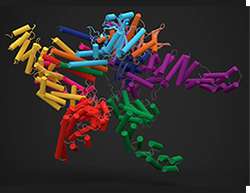Crystal structure of COP9 signalosome elucidated

Nicolas Thomä and his group at the Friedrich Miescher Institute for Biomedical Research have elucidated the crystal structure of the human COP9 signalosome, an important regulator of protein degradation. The crystal structure, published in today's issue of Nature, provides detailed insights into the molecular architecture of the eight-subunit complex and explains how specificity is achieved.
The COP9 signalosome (CSN) is a heavyweight in the disposal activities of a cell. Not only does it control about a fifth of all protein degradation processes, it is also – quite literally – a large-sized protein complex composed of eight distinct proteins, all of which are required for its function.
Scientists led by Nicolas Thomä at the Friedrich Miescher Institute for Biomedical Research have now elucidated the crystal structure of the entire human COP9 signalosome. This crystal structure provides detailed insights into the molecular architecture of the complex and makes it possible to draw conclusions about how it works.
CSN exerts its control through the regulation of numerous ligase enzymes known as Cullin RING E3 ubiquitin ligases (CRLs). This family of ubiquitin ligases, with approximately 200 members, adds small regulatory proteins (ubiquitins) to other proteins, thus targeting them for degradation. CSN inactivates CRLs by removing an activating protein, NEDD8, from their backbone.
With the aid of several complementary crystal structures, Thomä and his collaborators have now shown that six of the eight CSN proteins form a horseshoe-shaped ring. Within this ring, bundled together, lie CSN5 and CSN6. CSN5 is particularly important because it is the protein that removes NEDD8 once the ubiquitin ligase is bound. The scientists showed that still-inactive CSN5 is only guided to its appropriate place within the complex once the proteins forming the ring are assembled. Finally, the protein complex becomes functional when neddylated CRL is bound. This presence is sensed by CSN4, which communicates this state via CSN6 to CSN5, which in turn changes conformation to become enzymatically active.
"This induced fit mechanism ensures that CSN acts exclusively on neddylated CRLs, avoiding uncontrolled deneddylase activity," says Thomä. "Because CSN is also implicated in several cancers, the crystal structure gives us a better understanding of how specificity is generated, and how to interfere with CSN function. Last but not least, we are fairly proud to have been able to crystallize this heavyweight – obtaining the crystal structure of such a large protein complex nowadays still needs a lot of expertise, skill and maybe a little bit of luck."
More information: Lingaraju GM, Bunker RD, Cavadini S, Hess D, Hassiepen U, Renatus M, Fischer ES, Thomä NH. Crystal structure of the human COP9 signalosome. Nature. 2014 July 16, online.
Journal information: Nature

















